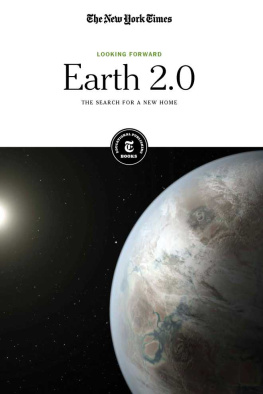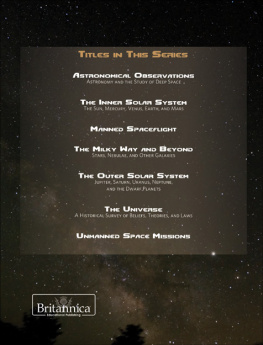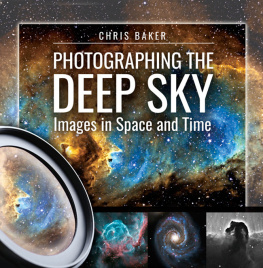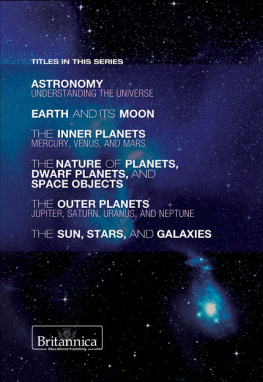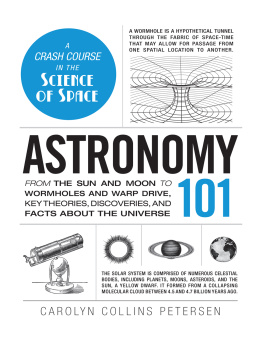ASTRONOMICAL OBSERVATIONS
ASTRONOMY AND THE STUDY OF DEEP SPACE
AN EXPLORERS GUIDE TO THE UNIVERSE
ASTRONOMICAL OBSERVATIONS
ASTRONOMY AND THE STUDY OF DEEP SPACE
EDITED BY ERIK GREGERSEN, ASSOCIATE EDITOR, ASTRONOMY AND SPACE EXPLORATION

Published in 2010 by Britannica Educational Publishing
(a trademark of Encyclopdia Britannica, Inc.)
in association with Rosen Educational Services, LLC
29 East 21st Street, New York, NY 10010.
Copyright 2010 Encyclopdia Britannica, Inc. Britannica, Encyclopdia Britannica, and the Thistle logo are registered trademarks of Encyclopdia Britannica, Inc. All rights reserved.
Rosen Educational Services materials copyright 2010 Rosen Educational Services, LLC.
All rights reserved.
Distributed exclusively by Rosen Educational Services.
For a listing of additional Britannica Educational Publishing titles, call toll free (800) 237-9932.
First Edition
Britannica Educational Publishing
Michael I. Levy: Executive Editor
Marilyn L. Barton: Senior Coordinator, Production Control
Steven Bosco: Director, Editorial Technologies
Lisa S. Braucher: Senior Producer and Data Editor
Yvette Charboneau: Senior Copy Editor
Kathy Nakamura: Manager, Media Acquisition
Erik Gregersen: Associate Editor, Astronomy and Space Exploration
Rosen Educational Services
Jeanne Nagle: Senior Editor
Nelson S: Art Director
Matthew Cauli: Designer
Introduction by Stephanie Watson
Library of Congress Cataloging-in-Publication Data
Astronomical observations: astronomy and the study of deep space / edited by Erik
Gregersen.1st ed.
p. cm.(An explorers guide to the universe)
In association with Britannica Educational Publishing, Rosen Educational Services.
Includes bibliographical references and index.
ISBN 978-1-61530-054-9 (eBook)
1. AstronomyPopular works. 2. Astronomical instrumentsPopular works.
3. AstronomyObservationsPopular works. I. Gregersen, Erik.
QB44.3.A88 2010
520dc22
2009036102
On the cover: Nestled high on a dormant volcano in Hawaii, the Keck I observatory, one of the most advanced telescopes in the world, prepares to scan the night skies. Joe McNally/Getty Images
CONTENTS








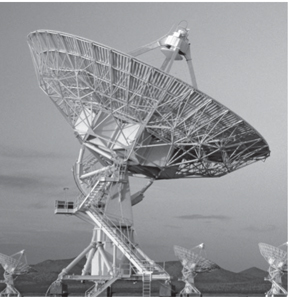




INTRODUCTION

The advent of telescopes brought astronomical observations into the modern age. Observing the night skies, however, is an ancient practice. Central Press/Hulton Archive/Getty Images
E veryone at one time or another has looked up at the night sky and wondered about the stars, planets, and other celestial bodies that lie beyond the Earths atmosphere. One doesnt have to be a professional astronomer to marvel at the enormity and complexity of the universe. All thats needed is the power of observation, perhaps aided by some type of magnification device such as a telescope, and a willingness to learn about the heavens.
This book, which details the tools and purposes of astronomy, could prove useful as well. Astronomical Observations chronicles the many accomplishments that have moved the field of astronomy forwardfrom the earliest theories about planetary motion to the development of modern telescopes. In its pages readers will also meet the people whose innovations made it possible to see farther and deeper into the skies, as well as those who meticulously charted the stars, planets, and constellations they found there.
Everyday citizens who lived thousands of years ago similarly gazed in wonder at that same night sky as people today, also trying to discern their place in the universe. To ancient peoples, the sky was a mystical place ruled by deities like the Egyptian Sun god Ra, who was thought to ride his great boat across the heavens every day. They believed the skies were responsible for events on Earth, and they looked to the heavens to predict the future. Todays astrological horoscopes are direct descendants of this practice.
Without modern telescopic tools for visualizing the farthest reaches of space, the ancient astronomers understanding of the universe was based primarily on direct observation and calculation. They meticulously watched and recorded what they saw in the skies, and their observations were often surprisingly sophisticated. After charting the movements of the stars over time, the Egyptians eventually learned that the star Siriuss rise in the eastern sky coincided with the Nile Rivers annual floods. The Egyptians were also the first to develop a solar calendar, more than 4,000 years ago, that looked very similar to what people use today.
Still, people were unable to visualize what lies beyond the sky surrounding Earth. At that time, they understandably assumed that the only world they knew sat at the centre of the universe, and that the Sun and all of the planets revolved around it. Early astronomers devised crude celestial spheres and globes to document their observations. However, later astronomical research led to the realization that the Earth actually occupies an infinitesimally small part of an almost incomprehensibly huge universe. There are one hundred billion stars in the Milky Way Galaxy alone.
Mapping the sky is not the only goal of astronomical discovery. Measuring how far planets and stars are from one another is another important application of astronomy. Distances in space can be difficult to determine when dealing with such enormous numberstrillions of miles, billions of years, and millions of billions of stars. Calculations are even more difficult when you consider that the universe has been continually expanding since the big bang nearly 14 billion years ago. Because the universe is expanding, the light that reaches Earth from distant galaxies will have taken billions of years to get here. That is why looking deep into space through a powerful telescope is somewhat like looking into a time machine. Astronomers are seeing the universe not as it is today, but rather as it looked billions of years ago.
Next page








